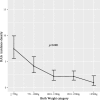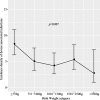Trends, risk factors and outcomes of healthcare-associated infections in a neonatal intensive care unit in Italy during 2013-2017
- PMID: 32183842
- PMCID: PMC7079437
- DOI: 10.1186/s13052-020-0799-3
Trends, risk factors and outcomes of healthcare-associated infections in a neonatal intensive care unit in Italy during 2013-2017
Abstract
Background: Healthcare-associated infections (HAIs) occur frequently in intensive care units (NICUs). The aim of this study was to analyze the results of surveillance of HAIs in a III level NICU in Naples, Italy during 2013-2017 and to compare with those obtained during 2006-2010.
Methods: The surveillance included 1265 neonates of all birth weight (BW) classes with > 2 days NICU stay. Infections were defined using standard Centers for Disease Control and Prevention definitions adapted to neonatal pathology.
Results: A total of 125 HAIs were registered during 2013-2017 with a frequency of 9.9% and an incidence density of 3.2 per 1000 patient days. HAIs occurred in all BW classes with a decreasing trend from the lowest to the highest BW classes (p = < 0.001). Central line-associated blood stream infection (CLABSI) was the most frequent infection (69.6%), followed by ventilator associated pneumonia (VAP) (20%), urinary tract infection (UTI) (8.8%) and necrotizing enterocolitis (NEC) (1.6%). Also, CLABSI and VAP incidence density decreased from lower to highest BW classes showing a significant trend (p = 0.007). Most frequent pathogens responsible for CLABSI were: Coagulase-negative staphylococci (CONS) (25.3%), Candida parapsilosis (21.8%), Pseudomonas aeruginosa (5.7), Escherichia coli and Klebsiella pneumoniae (6.8%). No microbiological diagnosis was achieved for 20.7% of CLABSI. Pseudomonas aeruginosa (28%), Stenotrophomonas maltophilia (20%), and CONS (20%) were the most frequent pathogens responsible for VAP. CLABSI incidence density showed no differences between 2006 and 2010 and 2013-2017, while VAP incidence density for the 751-100 g BW class was higher during 2006-2010 than during 2013-2017 (p = 0.006). A higher incidence of the CLABSI caused by Gram positive bacteria (p = 0.002) or by undetermined etiology (p = 0.01) was observed during 2013-2017 than during 2006-2010, while a significant lower incidence of VAP caused by Gram-negative bacteria was found during 2013-2017 than during 2006-2010 (p = 0.007).
Conclusion: HAIs in the NICU developed in all BW classes with a decreasing trend from the lowest to the highest BW classes in both study periods. Differences in the aetiology of CLABSI and VAP were found between the two study periods. This reinforces the importance of HAIs surveillance protocol in the NICU, which monitors microbiological isolates and use of medical devices for all BW classes of neonates.
Keywords: Active surveillance; Birth weight; Device utilization; Healthcare-associated infections; Neonatal intensive care unit.
Conflict of interest statement
The authors declare that they have no competing interests.
Figures




References
-
- Hocevar SN, Edwards JR, Horan TC, Morrell GC, Iwamoto M, Lessa FC. Device-associated infections among neonatal intensive care unit patients: incidence and associated pathogens reported to the National Healthcare Safety Network, 2006-2008. Infect Control Hosp Epidemiol. 2012;33(12):1200–1206. doi: 10.1086/668425. - DOI - PMC - PubMed
MeSH terms
Grants and funding
LinkOut - more resources
Full Text Sources

